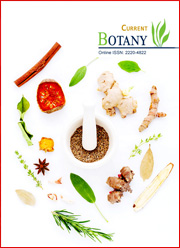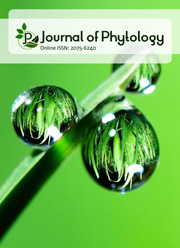Changes in germination, early seedling growth and morpho-physiology of sesame under PEG-induced osmotic Stress
DOI:
https://doi.org/10.25081/cb.2025.v16.9263Keywords:
Early seedling stage, Osmotic stress, Polyethylene glycol, Principal component analysis, Seed germination, SesameAbstract
The present study investigates the impact of polyethylene glycol (PEG) (0 and 25%) induced osmotic stress on germination, growth, morpho-physiological responses and stress tolerance indices of thirteen sesame (Sesamum indicum L.) genotypes at an early seedling stage. The experiments were conducted under lab-based controlled cultural conditions with two levels of PEG-6000 (0% and 25%) and thirteen genotypes using diverse seed colours (white, brown, light brown, and black) and twenty-two variables subjected to multivariable analysis. At 25% concentration, the principle component analysis (PCA) biplot classified thirteen sesame genotypes into two groups according to F values. The PCA biplot placed the tolerant (group-I) and sensitive (group-II) genotypes on opposite sides. Group-I contains eight genotypes viz. with black seed colour (IC-132300, GT-10), white seed colour (IC-96229, IC-132171, IC-205471, IC-203962) and light brown seed colours (IC-204966 and IC-131500) Group II contains five sensitive genotypes with brown seed colours such as YLM-17, YLM-66, YLM-11, Madhavi and Gowri, contributed from fresh weight, dry weight, chl a, chl b, total chlorophyll, carotenoids and chlorophyll stability index. The present study offers breeders a laboratory-based, reliable, and quick method for screening sesame germplasm to identify and develop drought-tolerant genotypes contributed from the rate of germination, germination percentage, root length, shoot length, root/shoot ratio, seedling length, dry weight, germination percentage stress tolerance index, root length stress tolerance index, shoot length stress tolerance index, seedling length stress tolerance index, fresh weight stress tolerance index, dry weight stress tolerance index, seedling vigour index and chl a/b.
Downloads
References
Abdul-Baki, A. A., & Anderson, J. D. (1973). Relationship between decarboxylation of glutamic acid and vigor in soybean seed. Crop Science, 13(2), 227-232. https://doi.org/10.2135/cropsci1973.0011183X001300020023x
Ahmed, M., Kheir, A. M. S., Mehmood, M. Z., Ahmad, S., & Hasanuzzaman, M. (2022). Changes in Germination and Seedling Traits of Sesame under Simulated Drought. Phyton-International Journal of Experimental Botany, 91(4), 713-726. https://doi.org/10.32604/phyton.2022.018552
Allel, D., Ben-Amar, A., Badri, M., & Abdelly, C. (2016). Salt tolerance in barley originating from harsh environment of North Africa. Australian Journal of Crop Science, 10(4), 438-451. https://doi.org/10.21475/ajcs.2016.10.04.p6663x
Aqaei, P., Weisany, W., Diyanat, M., Razmi, J., & Struik, P. C. (2020). Response of maize (Zea mays L.) to potassium nano-silica application under drought stress. Journal of Plant Nutrition, 43(9), 1205-1216. https://doi.org/10.1080/01904167.2020.1727508
Baghery, M. A., Kazemitabar, S. K., Dehestani, A., Mehrabanjoubani, P., & Zarrini, H. N. (2022). Assessment of agro-morphological traits and yield-based tolerance indices in sesame (Sesamum indicum L.) genotypes under drought stress. Indian Journal of Genetics and Plant Beeding, 82(3), 324-332. https://doi.org/10.31742/ISGPB.82.3.7
Baraki, F., Gebregergis, Z., Belay, Y., Berhe, M., Teame, G., Hassen, M., Gebremedhin, Z., Abadi, A., Negash, W., Atsbeha, A., & Araya, G. (2020). Multivariate analysis for yield and yield-related traits of sesame (Sesamum indicum L.) genotypes. Heliyon, 6(10), e05295. https://doi.org/10.1016/j.heliyon.2020.e05295
Barrs, H. D., & Weatherley, P. E. (1962). A re-examination of the relative turgidity technique for estimating water deficits in leaves. Australian Journal of Biological Sciences, 15(3), 413-428.
Boureima, S., Diouf, M., Amoukou, A. I., & Van Damme, P. (2016). Screening for sources of tolerance to drought in sesame induced mutants: Assessment of indirect selection criteria for seed yield. International Journal of Pure and Applied Bioscience, 4(1), 45-60. https://doi.org/10.18782/2320-7051.2218
Carleton, A. E., Cooper, C. S., & Wiesner, L. E. (1968). Effect of Seed Pod and Temperature on Speed of Germination and Seedling Elongation of Sainfoin (Onobrychis viciaefolia Scop.). Agronomy Journal, 60(1), 81-84. https://doi.org/10.2134/agronj1968.00021962006000010026x
Channaoui, S., El Idrissi, I. S., Mazouz, H., & Nabloussi, A. (2019). Reaction of some rapeseed (Brassica napus L.) genotypes to different drought stress levels during germination and seedling growth stages. OCL, 26, 23. https://doi.org/10.1051/ocl/2019020
Chikha, M. B., Hessini, K., Ourteni, R. N., Ghorbel, A., & Zoghlami, N. (2016). Identification of barley landrace genotypes with contrasting salinity tolerance at vegetative growth stage. Plant Biotechnology, 33(4), 287-295. https://doi.org/10.5511/plantbiotechnology.16.0515b
Cui, C., Liu, Y., Liu, Y., Cui, X., Sun, Z., Du, Z., Wu, K., Jiang, X., Mei, H., & Zheng, Y. (2021). Genome-wide association study of seed coat color in sesame (Sesamum indicum L.). Plos One, 16(5), e0251526. https://doi.org/10.1371/journal.pone.0251526
Dossa, K., Li, D., Wang, L., Zheng, X., Liu, A., Yu, J., Wei, X., Zhou, R., Fonceka, D., Diouf, D., Liao, B., Cissé, N., & Zhang, X. (2017). Transcriptomic, biochemical and physio-anatomical investigations shed more light on responses to drought stress in two contrasting sesame genotypes. Scientific Reports, 7, 8755. https://doi.org/10.1038/s41598-017-09397-6
Dossa, K., Li, D., Zhou, R., Yu, J., Wang, L., Zhang, Y., You, J., Liu, A., Mmadi, M. A., Fonceka, D., Diouf, D., Cissé, N., Wei, X., & Zhang, X. (2019). The genetic basis of drought tolerance in the high oil crop Sesamum indicum L. Plant Biotechnology Journal, 17(9), 1788-1803. https://doi.org/10.1111/pbi.13100
El Harfi, M., Hanine, H., Rizki, H., Latrache, H., & Nabloussi, A., 2016. Effect of Drought and Salt Stresses on Germination and Early Seedling Growth of Different Color-seeds of Sesame (Sesamum indicum L). International Journal of Agriculture & Biology, 18(6), 1088-1094.
Gopika, K., Ratnakumar, P., Guhey, A., Manikanta, C. L. N., Pandey, B. B., Ramya, K. T., & Rathnakumar, A. L. (2022). Physiological traits and indices to identify tolerant genotypes in sesame (Sesamum indicum L.) under deficit soil moisture condition. Plant Physiology Reports, 27(4), 744-754. https://doi.org/10.1007/s40502-022-00701-9
Hahm, T.-S., Park, S.-J., & Lo, Y. M. (2009). Effects of germination on chemical composition and functional properties of sesame (Sesamum indicum L.) seeds. Bioresource Technology, 100(4), 1643-1647. https://doi.org/10.1016/j.biortech.2008.09.034
Hegarty, T. W. (1978). The physiology of seed hydration and dehydration, and the relation between water stress and the control of germination: a review. Plant, Cell and Environment, 1(2), 101-119. https://doi.org/10.1111/j.1365-3040.1978.tb00752.x
Hellal, F. A., El-Shabrawi, H. M., Abd El-Hady, M., Khatab, I. A., El-Sayed, S. A. A., & Abdelly, C. (2018). Influence of PEG induced drought stress on molecular and biochemical constituents and seedling growth of Egyptian barley cultivars. Journal of Genetic Engineering and Biotechnology, 16(1), 203-212. https://doi.org/10.1016/j.jgeb.2017.10.009
Hota, T., Pradhan, C., & Rout, G. R. (2019). Identification of drought tolerant Sesamum genotypes using biochemical markers. Indian Journal of Experimental Biology, 57, 690-699.
Huang, B., Su, J., Zhang, G., Luo, X., Wang, H., Gao, Y., Ma, G., Wang, J., Cai, D., Zhang, X., & Huang, B. (2017). Screening for Eruca genotypes tolerant to polyethylene glycol-simulated drought stress based on the principal component and cluster analyses of seed germination and early seedling growth. Plant Genetic Resources, 15(2), 187-193. https://doi.org/10.1017/S1479262115000519
ISTA. (2019). International rules for seed testing, Rules. Seed Science and Technology, 13, 299-355.
Kadir, K., Talebi, R., & Hamidi, H. (2017). Multivariate analysis and drought stress tolerance indices in chickpea (Cicer arietinum L.) under different irrigation regimes. Journal of Experimental Biology and Agricultural Sciences, 5(1), 54-60. https://doi.org/10.18006/2017.5(1).054.060
Khan, M. N., Zhang, J., Luo, T., Liu, J., Ni, F., Rizwan, M., Fahad, S., & Hu, L. (2019). Morpho-physiological and biochemical responses of tolerant and sensitive rapeseed cultivars to drought stress during early seedling growth stage. Acta Physiologiae Plantarum, 41, 25. https://doi.org/10.1007/s11738-019-2812-2
Kouighat, M., Hanine, H., El Fechtali, M., & Nabloussi, A. (2021). First report of sesame mutants tolerant to severe drought stress during germination and early seedling growth stages. Plants, 10(6), 1166. https://doi.org/10.3390/plants10061166
Langyan, S., Yadava, P., Sharma, S., Gupta, N. C., Bansal, R., Yadav, R., Kalia, S., & Kumar, A. (2022). Food and nutraceutical functions of sesame oil: An underutilized crop for nutritional and health benefits. Food Chemistry, 389, 132990. https://doi.org/10.1016/j.foodchem.2022.132990
Lawlor, D. W. (1970). Absorption of polyethylene glycols by plants and their effects on plant growth. New Phytologist, 69(2), 501-513. https://doi.org/10.1111/j.1469-8137.1970.tb02446.x
Liang, J., Sun, J., Ye, Y., Yan, X., Yan, T., Rao, Y., Zhou, H., & Le, M. (2021). QTL mapping of PEG-induced drought tolerance at the early seedling stage in sesame using whole genome re-sequencing. Plos One, 16, e0247681. https://doi.org/10.1371/journal.pone.0247681
Lichtenthaler, H. K. (1987). Chlorophylls and carotenoids: pigments of pphotosynthetic biomembranes. Methods in Enzymology, 148, 350-382. https://doi.org/10.1016/0076-6879(87)48036-1
Mašková, T., & Herben, T. (2018). Root: shoot ratio in developing seedlings: How seedlings change their allocation in response to seed mass and ambient nutrient supply. Ecology and Evolution, 8(14), 7143-7150. https://doi.org/10.1002/ece3.4238
Mude, L. N., Mondam, M., Gujjula, V., Jinka, S., Pinjari, O. B., Panditi, V., Reddy, Y. N., & Patan, S. S. V. K. (2023). Morpho-physiological responses of finger millet genotypes to PEG-induced osmotic stress at an early seedling stage. Proceedings of the National Academy of Sciences, India Section B: Biological Sciences, 93, 337-350. https://doi.org/10.1007/s40011-022-01421-8
Mundada, P. S., Nikam, T. D., Kumar, S. A., Umdale, S. D., & Ahire, M. L. (2020). Morpho-physiological and biochemical responses of finger millet (Eleusine coracana (L.) Gaertn.) genotypes to PEG-induced osmotic stress. Biocatalysis and Agricultural Biotechnology, 23, 101488. https://doi.org/10.1016/j.bcab.2019.101488
Murthy, K. S., & Majumdar, S. K. (1962). Modification of the technique for determination of chlorophyll stability index in relation to studies of drought resistance in rice. Current Science, 31, 470-471.
Pandey, B. B., Ratnakumar, P., Kiran, B. U., Dudhe, M. Y., Lakshmi, G. S., Ramesh, K., & Guhey, A. (2021). Identifying traits associated with terminal drought tolerance in sesame genotypes. Frontiers in Plant Science, 12, 739896. https://doi.org/10.3389/fpls.2021.739896
Pandey, S. K., Das, A., Rai, P., & Dasgupta, T. (2015). Morphological and genetic diversity assessment of sesame (Sesamum indicum L.) accessions differing in origin. Physiology and Molecular Biology of Plants, 21, 519-529. https://doi.org/10.1007/s12298-015-0322-2
Ravitej, K. N., Ratnakumar, P., Pandey, B. B., Reddy, S. N., Shankar, V. G., & Padmaja, D. (2019). Morpho-physiological and yield traits of sesame (Sesamum indicum L.) varieties under rainfed conditions. Journal Oilseeds Research, 36(3), 193-198.
Razzaq, H., Tahir, M. H. N., Sadaqat, H. A., & Sadia, B. (2017). Screening of sunflower (Helianthus annus L.) accessions under drought stress conditions, an experimental assay. Journal of Soil Science and Plant Nutrition, 17(3), 662-671. https://doi.org/10.4067/S0718-95162017000300009
Sinclair, T. R., & Ludlow, M. M. (1985). Who taught plants thermodynamics? The unfulfilled potential of plant water potential. Australian Journal of Plant Physiology, 12(3), 213-217. https://doi.org/10.1071/PP9850213
Sivakumar, J., Reddy, M. S., Sergeant, K., Hausman, J. F., Khan, P. S. S. V., & Basha, P. O. (2023). Principal component analysis-assisted screening and selection of salt-tolerant tomato genotypes. Plant Physiology Reports, 28, 272-288. https://doi.org/10.1007/s40502-023-00726-8
Sravanthi, A. L., Ratnakumar, P., Reddy, S. N., Eswari, K. B., Pandey, B. B., Manikanta, C. L. N., Ramya, K. T., Sonia, E., Mohapatra, S., Gopika, K., Anusha, P. L., & Yadav, P. (2021). Morpho-physiological, quality traits and their association with seed yield in sesame (Sesamum indicum L.) indigenous collection under deficit moisture stress. Plant Physiology Reports, 27, 132-142.
Stavridou, E., Lagiotis, G., Kalaitzidou, P., Grigoriadis, I., Bosmali, I., Tsaliki, E., Tsiotsiou, S., Kalivas, A., Ganopoulos, I., & Madesis, P. (2021). Characterization of the genetic diversity present in a diverse sesame landrace collection based on phenotypic traits and EST-SSR markers coupled with an HRM analysis. Plants, 10(4), 656. https://doi.org/10.3390/plants10040656
Ward, J. H. (1963). Hierarchical grouping to optimize an objective function. Journal of the American Statistical Association, 58(301), 236-244. https://doi.org/10.1080/01621459.1963.10500845
Wellburn, A. R. (1994). The spectral determination of chlorophylls a and b, as well as total carotenoids, using various solvents with spectrophotometers of different resolution. Journal of Plant Physiology, 144(3), 307-313. https://doi.org/10.1016/S0176-1617(11)81192-2
You, J., Zhang, Y., Liu, A., Li, D., Wang, X., Dossa, K., Zhou, R., Yu, J., Zhang, Y., Wang, L., & Zhang, X. (2019). Transcriptomic and metabolomic profiling of drought-tolerant and susceptible sesame genotypes in response to drought stress. BMC Plant Biology, 19, 267. https://doi.org/10.1186/s12870-019-1880-1
Zheng, X., Giuliano, G., & Al-Babili, S. (2020). Carotenoid biofortification in crop plants: citius, altius, fortius. Biochimica et Biophysica Acta (BBA) - Molecular and Cell Biology of Lipids, 1865(11), 158664. https://doi.org/10.1016/j.bbalip.2020.158664
Zraibi, L., Nabloussi, A., Kajeiou, M., Elamrani, A., Khalid, A., & Caid, H. S. (2011). Comparative germination and seedling growth response to drought and salt stresses in a set of safflower (Carthamus tinctorius) varieties. Seed Technology, 33, 39-52.
Published
How to Cite
Issue
Section
Copyright (c) 2025 Khadar Basha Shaik, Naseem Shaik, Suneetha Vallepu, Madakka Mekapogu, Shaik Sha Valli Khan Patan

This work is licensed under a Creative Commons Attribution-NonCommercial 3.0 Unported License.



 .
.